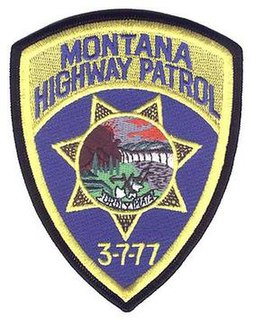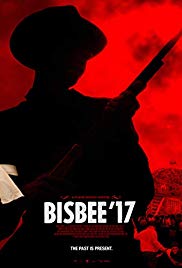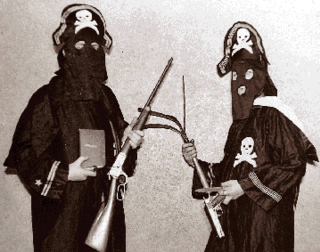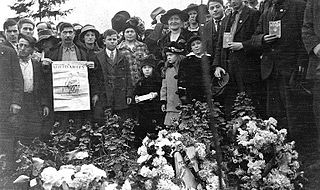 W
WVigilantism is the act of enforcement, investigation or punishment of perceived offenses without legal authority.
 W
W3-7-77 was the symbol used by the Montana Vigilantes in Virginia City, Montana, USA in the 19th century. People who found the numbers '3-7-77' painted on their tent or cabin knew that they had better leave the area or expect to be on the receiving end of vigilantism.
 W
WThe 1934 West Coast Waterfront Strike lasted eighty-three days, and began on May 9, 1934 when longshoremen in every US West Coast port walked out. The strike peaked with the death of two workers on "Bloody Thursday" and the San Francisco General Strike which stopped all work in the major port city for four days and led ultimately to the settlement of the West Coast Longshoremen's Strike.
 W
WThe Bald Knobbers were a group of vigilantes in the Ozark region of southwest Missouri from 1855 to 1889. They are commonly depicted wearing black horned hoods with white outlines of faces painted on them, a distinction that evolved during the rapid proliferation of the group into neighboring counties from its Taney County origins. The group got its name from the grassy bald knob summits of the nearby Ozark Mountains. The hill where they first met, Snapp's Bald, is located just north of Kirbyville, Missouri. An article in the October 5, 1898 issue of Springfield, Missouri's The Leader-Democrat states:Henry Westmoreland is in from Beaver County, Oklahoma, which was formerly a part of the strip known as No-Man's-Land. He says grass is in abundance and cattle plenty, but no efforts are made at raising crops there, except roughness and alfalfa. The venerable gentleman owned a ranch in Taney County at the time of the Bald Knob uprising, and was the man who gave that organization its name.
 W
WBisbee '17 is a 2018 American film directed by Robert Greene. Partially documentary and partially based on a true story Western, it reflects on the events of the 1917 Bisbee Deportation, 100 years later; it is set in Bisbee, Arizona, both in 1917 and 2017.
 W
WThe Bisbee Deportation was the illegal kidnapping and deportation of about 1,300 striking mine workers, their supporters, and citizen bystanders by 2,000 members of a deputized posse, who arrested them beginning on July 12, 1917, in Bisbee, Arizona. The action was orchestrated by Phelps Dodge, the major mining company in the area, which provided lists of workers and others who were to be arrested to the Cochise County sheriff, Harry C. Wheeler. Those arrested were taken to a local baseball park before being loaded onto cattle cars and deported 200 miles (320 km) to Tres Hermanas in New Mexico. The 16-hour journey was through desert without food and with little water. Once unloaded, the deportees, most without money or transportation, were warned against returning to Bisbee. The US government soon brought in members of the US Army to assist with relocating the deportees to Columbus, New Mexico.
 W
WThe Black Legion was a white supremacist terrorist organization active in the Midwestern United States during the Great Depression of the 1930s. It split off from the Ku Klux Klan. According to historian Rick Perlstein, the FBI estimated its membership "at 135,000, including a large number of public officials, possibly including Detroit’s police chief." In 1936 the group was suspected of having killed as many as 50 people, according to the Associated Press, including Charles Poole, an organizer for the federal Works Progress Administration.
 W
WThe Bogalusa saw mill killings was a racial attack that killed four labor organizers on November 22, 1919. It was mounted by the white paramilitary group the Self-Preservation and Loyalty League (SPLL) in Thibodaux, Louisiana. They were supported by the owners of Great Southern Lumber Company, a giant logging corporation, that hoped to prevent union organization and the Black and White labor organizations from merging.
 W
WThe Centralia Tragedy, also known as the Centralia Conspiracy and the Armistice Day Riot, was a violent and bloody incident that occurred in Centralia, Washington, on November 11, 1919, during a parade celebrating the first anniversary of Armistice Day. The conflict between the American Legion and Industrial Workers of the World members resulted in six deaths, others being wounded, multiple prison terms, and an ongoing and especially bitter dispute over the motivations and events that precipitated the event. Both Centralia and the neighboring town of Chehalis had a large number of World War I veterans, with robust chapters of the Legion and many IWW members, some of whom were also war veterans.
 W
WThe cotton pickers strike of 1891 was a labor action of African-American sharecroppers in Lee County, Arkansas in September, 1891. The strike led to open conflict between strikers and plantation owners, racially-motivated violence, and both a sheriff's posse and a lynching party. One plantation manager, two non-striking workers, and some twelve strikers were killed during the incident. Nine of those strikers were hung in a mass lynching on the evening of September 29.
 W
WThe Earp Vendetta Ride was a deadly search by a federal posse led by Deputy U.S. Marshal Wyatt Earp for a loose confederation of outlaw "Cowboys" they believed had ambushed his brothers Virgil and Morgan Earp, maiming the former and killing the latter. The two Earp brothers had been attacked in retaliation for the deaths of three Cowboys in the Gunfight at the O.K. Corral on October 26, 1881. From March 20 to April 15, 1882, the federal posse searched southeast Cochise County, Arizona Territory for the men they believed were responsible for the attacks on Virgil and Morgan. Several suspects had been identified and were charged, but were soon released by the court, owing in some cases to legal technicalities and in others to the strength of alibis provided by Cowboy confederates. Wyatt hoped that the legal system would bring the Cowboys to justice, but after suspects in both ambushes were freed, Wyatt resolved to take matters into his own hands.
 W
WThe Everett Massacre was an armed confrontation between local authorities and members of the Industrial Workers of the World (IWW) union, commonly called "Wobblies". It took place in Everett, Washington on Sunday, November 5, 1916. The event marked a time of rising tensions in Pacific Northwest labor history.
 W
WThe Shootout on Juneau Wharf was a gunfight between Jefferson Randolph "Soapy" Smith, Frank H. Reid, and Jesse Murphy that took place on Friday, July 8, 1898, at approximately 9:15 p.m. in Skagway, District of Alaska, in the United States. Smith was shot in the heart and died shortly afterwards, and Reid died of his injuries 12 days later.
 W
WThe Lincoln County War was an Old West conflict between rival factions which began in 1878 in New Mexico Territory, the predecessor of the state of New Mexico, and continued until 1881. The feud became famous because of the participation of the criminal William H. Bonney. Other notable participants included Sheriff William J. Brady, cattle rancher John Chisum, lawyer and businessman Alexander McSween, James Dolan and Lawrence Murphy.
 W
WKen Rex McElroy was a resident of Skidmore, Missouri, United States. Known as "the town bully", McElroy's unsolved killing became the focus of international attention. Over the course of his life, McElroy was accused of dozens of felonies, including assault, child molestation, statutory rape, arson, animal cruelty, hog and cattle rustling, and burglary.
 W
WThe Minuteman Project was an organization which was founded in the United States in August 2004 by a group of private individuals who sought to extrajudicially monitor the United States–Mexico border's flow of illegal immigrants. Founded by Jim Gilchrist and Chris Simcox, the organization's name is derived from the name of the Minutemen, militiamen who fought in the American Revolution. The Minuteman Project describes itself as "a citizens' Neighborhood Watch on our border", and it has attracted the attention of the media due to its focus on the issue of illegal immigration.
 W
WThe history of vigilante justice and the Montana Vigilantes began in 1863 in what was at the time a remote part of eastern Idaho Territory. Vigilante activities continued, although somewhat sporadically, through the Montana Territorial period until the territory became the state of Montana on November 8, 1889. Vigilantism arose because territorial law enforcement and the courts had very little power in the remote mining camps during the territorial period.
 W
WOath Keepers is an American far-right anti-government militia organization composed of current and former military and police who claim to be defending the Constitution of the United States. It encourages its members to disobey orders which they believe would violate the U.S. Constitution. The organization claims a membership of 35,000 as of 2016, though the Anti-Defamation League (ADL) has estimated its membership at several thousand. Researchers estimate the number as probably no higher than 5,000.
 W
WOkemah is the largest city in and the county seat of Okfuskee County, Oklahoma, United States. It is the birthplace of folk music legend Woody Guthrie. Thlopthlocco Tribal Town, a federally recognized Muscogee Indian tribe, is headquartered in Okemah. The population was 3,223 at the 2010 census, a 6.1 percent increase from 3,038 in 2000. In that census, about 26.6 percent of the residents identified themselves as Native American.
 W
WPerverted Justice Foundation, Inc., more commonly known as Perverted-Justice, is an American organization based in California and Oregon which has investigated, identified, and publicized the conduct of adults who have used chat rooms and other social media in order to solicit online sexual conversations and in-person meetings with minors. Their website serves as an archive of collected data on these investigations, which they make available in order to assist law enforcement and the public in understanding the behavior and child grooming techniques of online hebephiles.
 W
WThe Rain City Superhero Movement was a Seattle-based organization in the U.S. state of Washington. It was composed of costumed activists who describe themselves as a crime-fighting brigade. Witnesses have reported that the group has intervened in crimes on several occasions, while the police maintained they would prefer that individuals other than sworn officers not place themselves in danger, and act as good witnesses instead.
 W
WRiding the rail was a punishment most prevalent in the United States in the 18th and 19th centuries in which an offender was made to straddle a fence rail held on the shoulders of two or more bearers. The subject was then paraded around town or taken to the city limits and dumped by the roadside.
 W
WThe San Francisco Committee of Vigilance was a vigilante group formed in 1851. The catalyst for its formation was the criminality of the Sydney Ducks gang. It was revived in 1856 in response to rampant crime and corruption in the municipal government of San Francisco, California. The need for extralegal intervention was apparent with the explosive population growth following the discovery of gold in 1848. The small town of about 900 individuals grew to a booming city of over 20,000 very rapidly. This overwhelming growth in population made it nearly impossible for the previously established law enforcement to regulate any longer which resulted in the organization of vigilantes.
 W
WTarring and feathering is a form of public torture and punishment used to enforce unofficial justice or revenge. It was used in feudal Europe and its colonies in the early modern period, as well as the early American frontier, mostly as a type of mob vengeance.
 W
WThe Thibodaux massacre was a racial attack mounted by white paramilitary groups in Thibodaux, Louisiana in November 1887. It followed a three-week strike during the critical harvest season by an estimated 10,000 workers against sugar cane plantations in four parishes: Lafourche, Terrebonne, St. Mary, and Assumption.
 W
WThe history of union busting in the United States dates back to the Industrial Revolution in the 19th century which produced a rapid expansion in factories and manufacturing capabilities. As workers moved away from farm work to factories, mines and other hard labor, they faced harsh working conditions such as long hours, low pay and health risks. Children and women worked in factories and generally received lower pay than men. The government did little to limit these conditions. Labor movements in the industrialized world developed that lobbied for better rights and safer conditions. Shaped by wars, depressions, government policies, judicial rulings, and global competition, the early years of the battleground between unions and management were adversarial and often identified with aggressive hostility. Contemporary opposition to trade unions known as union busting started in the 1940s and continues to present challenges to the labor movement. Union busting is a term used by labor organizations and trade unions to describe the activities that may be undertaken by employers, their proxies, workers and in certain instances states and governments usually triggered by events such as picketing, card check, worker organizing, and strike actions. Labor legislation has changed the nature of union busting, as well as the organizing tactics that labor organizations commonly use.
 W
WWhitecapping was a violent lawless movement among farmers that occurred specifically in the United States during the late 19th and early 20th centuries. It was originally a ritualized form of extralegal actions to enforce community standards, appropriate behavior, and traditional rights. However, as it spread throughout the poorest areas of the rural South after the Civil War, white members operated from economically driven and anti-black biases. States passed laws against it, but whitecapping continued into the early 20th century.